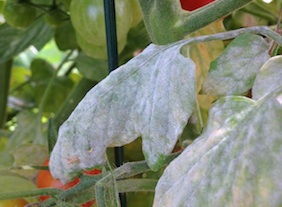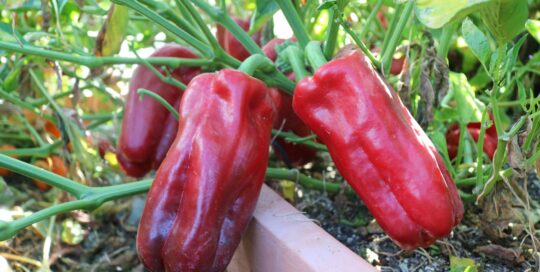Powdery Mildew on Tomatoes
Views: 4897

Thanks to those pesky flea beetles ravaging my cold crops, the best performers in my community garden plot this season are my tomatoes.
Well, sort of.
I say “sort of” because, unlike last year, the tomatoes aren’t suffering from blight or tomato blossom end rot. Leaves are green, tomatoes are full and fruity (if not yet ripening), and the vines are growing and growing and growing. All good signs.
BUT, those green leaves have been turning a bit whitish. Call it a ghostly green or a hazy green. This, my friends, is called powdery mildew.
Powdery mildew on tomatoes
Powdery mildew is a fungus (actually, several different host-specific fungi types) that appears on not just the leaves of the plant, but also on the stems, branches, and developing flowers and growing points of the plant.
While a plant with powdery mildew won’t die because of the infestation, it will suffer greatly. The whitish mildew covering the leaves will slow down photosynthesis, basically preventing the plant from “eating.” Growth will slow, infected leaves will eventually fall, and the fruit will suffer in taste.
What causes it?
Spores can overwinter in composted debris and appear the following season. They also can arrive in your garden from wind.
While spores are typically around in all types of conditions, the conditions that are very encouraging to their development are over-crowded plantings and high humidity.
I confess, my tomatoes are planted a little too closely, and we’ve had some damp and humid conditions this summer. Plants that were infected the most were ones I DID NOT stake or put into tomato cages. The ones whose leaves and vines were a jumbled mess on the ground.
Stop powdery mildew
Remove infected leaves from the plants as they appear. If it’s out of control on a plant, remove the entire plant and take it away from the garden completely. Removing infected leaves AND additional small leaves here and there will help improve air circulation and help alleviate some spore-inducing conditions.
Keep in mind that water helps spread the spores. Avoid getting water on the infected leaves and water the plants directly at ground level. Rain, of course, can foul these plans.
Lastly, try a fungicide. There are many traditional and organic solutions available, so ask your friendly local garden center what they recommend for tomatoes. You also may find a good recipe for a homemade solution.
Because I have been removing infected leaves and staying on top of the powdery mildew problem, I haven’t had to resort to a fungicide yet, although I believe I will have to do that soon. Some leaves are starting to fall, and powdery spots are appearing on the tomato stems.
Stay on top of your powdery mildew removal and see how long you can hold out, too.
Meet Ellen Wells
When you’re raised on a farm, you can’t help but know a thing or two about gardening. Ellen Wells is our expert on edible gardening.…
Ellen's Recent Posts

Pepper Red Impact an All-America Selections Winner






